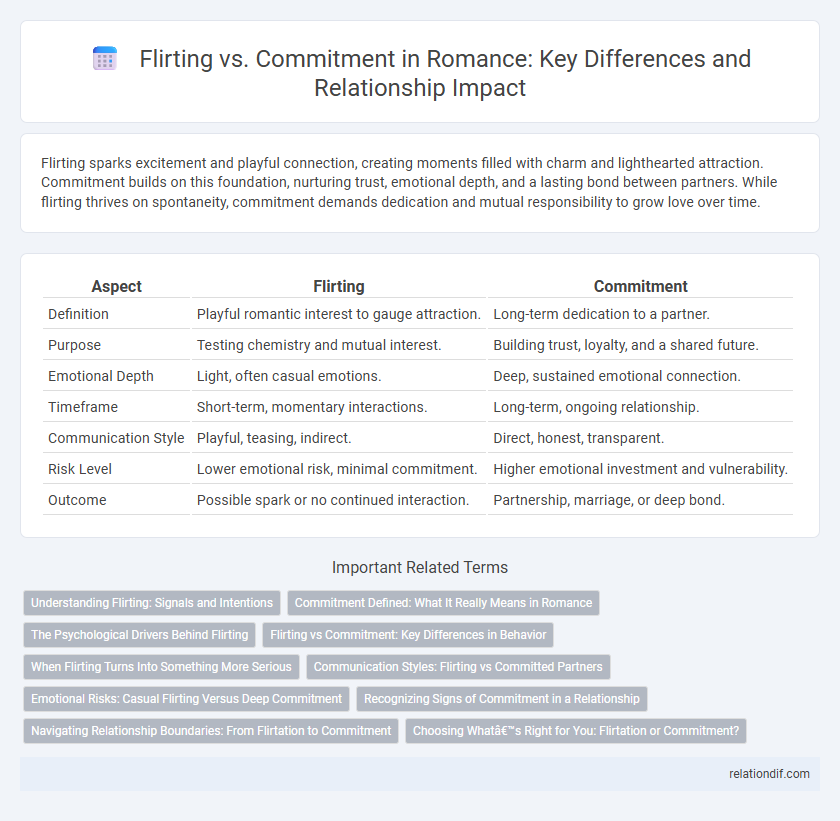Flirting sparks excitement and playful connection, creating moments filled with charm and lighthearted attraction. Commitment builds on this foundation, nurturing trust, emotional depth, and a lasting bond between partners. While flirting thrives on spontaneity, commitment demands dedication and mutual responsibility to grow love over time.
Table of Comparison
| Aspect | Flirting | Commitment |
|---|---|---|
| Definition | Playful romantic interest to gauge attraction. | Long-term dedication to a partner. |
| Purpose | Testing chemistry and mutual interest. | Building trust, loyalty, and a shared future. |
| Emotional Depth | Light, often casual emotions. | Deep, sustained emotional connection. |
| Timeframe | Short-term, momentary interactions. | Long-term, ongoing relationship. |
| Communication Style | Playful, teasing, indirect. | Direct, honest, transparent. |
| Risk Level | Lower emotional risk, minimal commitment. | Higher emotional investment and vulnerability. |
| Outcome | Possible spark or no continued interaction. | Partnership, marriage, or deep bond. |
Understanding Flirting: Signals and Intentions
Flirting involves subtle signals such as sustained eye contact, playful teasing, and light physical touch, which convey interest and attraction without explicit commitment. Understanding these cues helps differentiate casual interaction from genuine romantic intent, revealing the sender's willingness to explore a deeper connection or simply enjoy momentary engagement. Recognizing the distinction between flirtation and commitment reduces misunderstandings and fosters clearer communication in romantic relationships.
Commitment Defined: What It Really Means in Romance
Commitment in romance involves a deep emotional investment and a mutual agreement to prioritize the relationship over temporary attractions or casual flirtation. Unlike flirting, which centers on playful, often superficial interactions aimed at sparking initial interest, commitment demands consistency, trust, and long-term dedication. Understanding commitment means recognizing the importance of shared goals, vulnerability, and the willingness to work through challenges together.
The Psychological Drivers Behind Flirting
Flirting activates the brain's reward system by releasing dopamine and oxytocin, fostering feelings of excitement and bonding. It serves as a social tool for signaling interest and testing compatibility without immediate commitment. The psychological drivers behind flirting include the desire for validation, the thrill of novelty, and the exploration of potential relationships before deeper emotional investment.
Flirting vs Commitment: Key Differences in Behavior
Flirting often involves playful, spontaneous interactions characterized by lighthearted teasing, body language cues, and subtle compliments aimed at sparking interest without deeper emotional investment. Commitment requires consistent, transparent communication, mutual trust, and long-term dedication, reflecting a sincere intention to build and maintain a stable romantic relationship. Understanding these key behavioral differences highlights how flirting serves as an initial connection phase, while commitment anchors romantic partnerships in reliability and emotional security.
When Flirting Turns Into Something More Serious
Flirting serves as a playful and essential stage in romantic interactions, allowing individuals to gauge mutual attraction and compatibility. When initial sparks develop into deeper emotional connections, communication evolves from lighthearted banter to meaningful conversations about values and future goals. This transition marks the shift from casual encounters to committed relationships, highlighting the importance of trust and emotional investment in sustaining long-term love.
Communication Styles: Flirting vs Committed Partners
Flirting often relies on playful, light-hearted communication filled with teasing, humor, and subtle hints of interest, creating an atmosphere of excitement and curiosity. In contrast, committed partners prioritize clear, honest, and emotionally vulnerable dialogue that fosters trust, understanding, and long-term connection. Recognizing these distinct communication styles can improve relationship dynamics by aligning expectations and emotional needs.
Emotional Risks: Casual Flirting Versus Deep Commitment
Casual flirting often involves minimal emotional investment, allowing individuals to enjoy lighthearted interactions without significant vulnerability. In contrast, deep commitment requires opening oneself to greater emotional risks, such as fear of rejection, trust issues, and potential heartbreak. Understanding these emotional dynamics helps navigate the balance between fleeting attractions and meaningful, lasting relationships.
Recognizing Signs of Commitment in a Relationship
Recognizing signs of commitment in a relationship involves observing consistent communication, mutual respect, and shared future planning between partners. Unlike casual flirting, commitment is marked by emotional availability, prioritizing each other's needs, and integrating lives beyond surface-level attraction. Key indicators include introducing each other to close social circles, making joint decisions, and expressing vulnerability openly.
Navigating Relationship Boundaries: From Flirtation to Commitment
Navigating relationship boundaries requires understanding the nuanced shift from playful flirtation to genuine commitment, where clear communication fosters trust and emotional safety. Recognizing the signals and intentions behind flirtation helps partners establish mutual expectations, preventing misunderstandings that can hinder intimacy. Successful transitions from casual interactions to committed relationships depend on aligning values and prioritizing consistent effort to build lasting emotional bonds.
Choosing What’s Right for You: Flirtation or Commitment?
Flirting offers playful interaction and short-term excitement, while commitment requires emotional investment and long-term trust-building. Understanding personal desires and relationship goals helps determine whether casual connections or deep partnerships align better with your values. Prioritizing self-awareness ensures a fulfilling romantic experience tailored to individual needs.
flirting vs commitment Infographic

 relationdif.com
relationdif.com